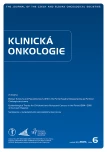Rare Hereditary Burden associated with a Hypercalcemic Small-Cell Carcinoma of Cervix in a Young Female Patient
Authors:
L. Hruška 1; I. Sirák 1; J. Laco 2; P. Fridrichová 3; H. Nosková 4; O. Slabý 4; K. Pál 4; V. Bočkayová 1; M. Hodek 1; J. Petera 1
Authors place of work:
Klinika onkologie a radioterapie FN Hradec Králové
1; Fingerlandův ústav patologie, FN Hradec Králové
2; Oddělení lékařské genetiky, FN Hradec Králové
3; CEITEC – Středoevropský technologický institut, Masarykova univerzita, Brno
4
Published in the journal:
Klin Onkol 2019; 32(6): 456-462
Category:
Kazuistika
doi:
https://doi.org/10.14735/amko2019456
Summary
Background: Oncological diseases have, in most cases, a multifactorial etiology, composed of a combination of external and internal environmental factors. Hereditary tumorous syndromes are mostly autosomal dominant diseases with incomplete but very high penetrance.
Observation: The patient, an 18-year-old virgin female, consulted a gynecologist in June 2018 because of metrorrhagia. Magnetic resonance imaging revealed a cervical tumor with the dimensions 80 × 90 × 80 mm. Histological analysis confirmed the presence of a very rare hypercalcemic type of small-cell carcinoma of the cervix. Further investigation of the germinal exom of the patient showed pathological variations in genes PALB2 and BRCA2, presented with recommendation of detailed examination by medical genetics.
Conclusion: Clinical experience with this type of tumor is very limited, but it still comes with some useful outcome. Small cell carcinomas of the gynecologic tract are very rare, aggressive diseases, with very poor prognosis, affecting mainly young women. Their origin is most often the ovaries, based on most clinical data, but these tumor also localize to the endometrium, cervix, vagina and vulva. It is an extremely rare type of cancer, for which clinical data is scant due to the extremely low number of reported cases. In this patient, the carcinoma had an unusual genetical mutation burden, which she inherited from her parents. In the light of these findings, we recommend that patients suspected of having a small-cell of the gynecologic tract provide a detailed family history, and that genetic testing be considered in similar cases.
This work was supported by MH CR grant 16-33209A and research program of Charles University Progress Q40/06.
The authors declare they have no potential conflicts of interest concerning drugs, products, or services used in the study.
The Editorial Board declares that the manuscript met the ICMJE recommendation for biomedical papers.
Submitted: 10. 6. 2019
Accepted: 9. 9. 2019
Keywords:
hereditary neoplastic syndromes – PALB2, BRCA2 mutation – whole exome sequencing – small-cell carcinoma, hypercalcemic type – rare cervical cancer
Zdroje
1. Tomášek J, Abrahámová J, Adam Z et al. Onkologie – minimum pro praxi. Mlečice: Axonite 2015: 44–52.
2. Genetika-biologie.cz. Šípek A. Hereditární nádorové syndromy. 2010–2014. [online]. Dostupné z: http: //www.genetika-biologie.cz/hereditarni-nadorove-syndromy.
3. Wikipedia.org. Exom. [online]. Dostupné z: https: //cs.wikipedia.org/wiki/Exom.
4. Biogen.cz. Molekulární biologie a genetika. [online]. Dostupné z: https: //biogen.cz/sekvenovani-lidskeho-exomu.
5. Wikiskripta.eu. BRCA. [online]. Dostupné z: https: //www.wikiskripta.eu/w/BRCA.
6. Wikipedia.org. PALB2. [online]. Dostupné z: https: //en.wikipedia.org/wiki/PALB2.
7. Linkos.cz. Česká onkologická společnost ČLS JEP. Hereditární syndrom nádorů prsu a/nebo ovaria. [online]. Dostupné z: https: //www.linkos.cz/lekar-a-multidisciplinarni-tym/geneticka-rizika/nadorove-syndromy/hereditarni-syndrom-nadoru-prsu-a-nebo-ovaria/.
8. Plevová P, Geržová H. Vzácné pediatrické ovariální tumory a jejich genetické příčiny. Klin Onkol 2019; 32 (Suppl 2): 2S79–2S91. doi: 10.14735/amko2019S79.
9. Jelinic P, Ricca J, van Oudenhove E et al. Immune-active microenvironment in small cell carcinoma of the ovary, hypercalcemic type: rationale for immune checkpoint blockade. J Natl Cancer Inst 2018; 110 (7): 787–790. doi: 10.1093/jnci/djx277.
10. Cohen JG, Chan JK, Kapp DS. The management of small-cell carcinomas of the gynecologic tract. Curr Opin Oncol 2012; 24 (5): 572–579. doi: 10.1097/CCO.0b0 13e3283565ed6.
11. Young RH, Oliva E, Scully RE. Small cell carcinoma of the ovary, hypercalcemic type. A clinicopathological analysis of 150 cases. Am J Surg Pathol 1994; 18 (11): 1102–1116. doi: 10.1097/00000478-199411000-00 004.
12. Kascak P, Zamecnik M, Bystricky B. Small cell carcinomama of the ovary (hypercalcemic type): malignant rhabdoid tumor. Case Rep Oncol 2016; 9 (2): 305–311. doi: 10.1159/000446694.
13. Wang JJ, Liu Q, Wu N et al. Ovarian small-cell carcinoma hypecalcemic type successfully treated: case report and literature review. Onco Targets Ther 2016; 9: 1409–1414. doi: 10.2147/OTT.S97170.
14. Ghazi A, Ayaz A, Hamid T et al. Small cell carcinoma of the ovary hypercalcemic type (SCCOHT): a rare case after in vitro fertilization (IVF). Pak J Med Sci 2017; 33 (1): 241–244. doi: 10.12669/pjms.331.11634.
Štítky
Dětská onkologie Chirurgie všeobecná OnkologieČlánek vyšel v časopise
Klinická onkologie

2019 Číslo 6
- Metamizol jako analgetikum první volby: kdy, pro koho, jak a proč?
- MUDr. Lenka Klimešová: Multioborová vizita může být klíčem k efektivnější perioperační léčbě chronické bolesti
- Realita léčby bolesti v paliativní péči v Německu
Nejčtenější v tomto čísle
- Extravazace (paravazace) cytostatik – doporučení pro standardní péči v rámci České republiky ze spolupráce Sekce podpůrné léčby České onkologické společnosti ČLS JEP, Onkologické sekce České asociace sester a Společnosti pro porty a permanentní katétry
- Vzácný nález hereditární zátěže u mladé pacientky s hyperkalcemickým malobuněčným karcinomem hrdla dělohy
- Tranzice péče o onkologické pacienty z dětského do dospělého věku
- Výsledky léčby bortezomibem a thalidomidem u nově diagnostikovaných netransplantovaných pacientů s mnohočetným myelomem jsou srovnatelné
